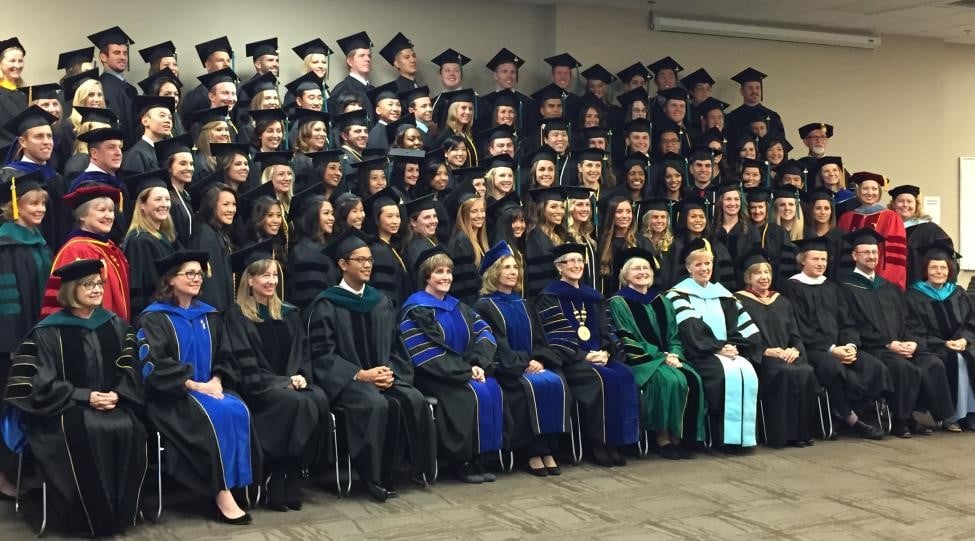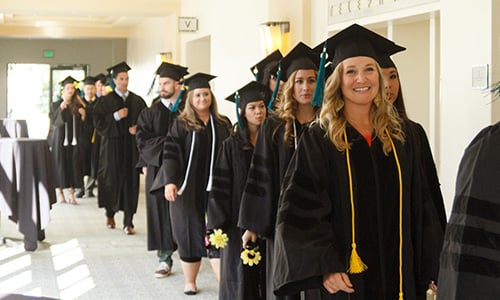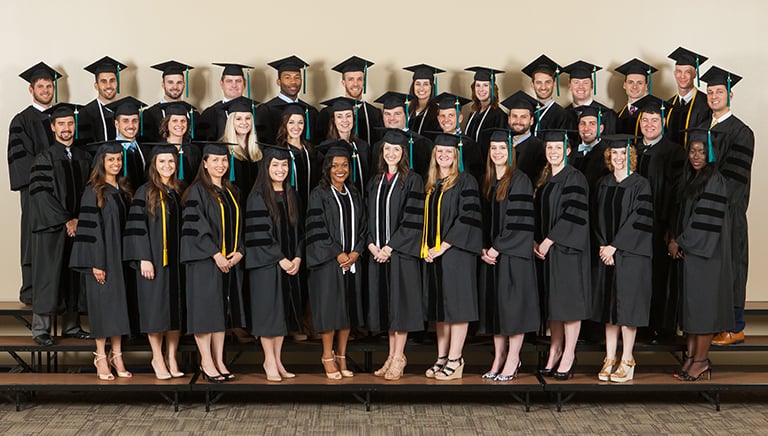
At USAHS, we’re proud of our “culture of innovation,” which leverages advancements in technology to prepare students to deliver cutting-edge healthcare services. Our students are learning in ways that promise to make their future peers envious and their future patients healthier.
“It’s not just about cool technology,” says Maria Puzziferro, PhD, Dean of Teaching, Learning and Innovation at USAHS. “It’s about our culture and our mindset—about following trends, emerging ideas, technologies, tools, and systems that are the future of healthcare. It’s about people coming together to solve complex problems for the greater good, and applying tools that enable a positive impact on patient outcomes.”
Dr. Puzziferro spoke to us about seven innovations that USAHS is leveraging to advance this culture—and graduate exemplary practitioners.
1. Centers for Innovative Clinical Practice (CICPs). Each of our five campuses features a
state-of-the-art clinical simulation center with real hospital beds and medical equipment. Working with their peers from other disciplines to role-play scenarios, students practice treating mock patients in interprofessional teams.
“Doing the role-plays in the CICPs was nerve-wracking,” says Doctor of Occupational Therapy (OTD) student Cortney Yap. “But it prepared me for my fieldwork. There is technology in my fieldwork setting that I had used in the sim lab. I feel more confident because I’d already been introduced to the equipment and concepts.”
“In the safe learning environment of simulation, students can practice working hands-on with patient monitoring systems, healthcare equipment, standardized patients, electronic charting, and other technologies,” says Elisabeth McGee, PhD, DPT, MOT, CHT, MTC, CHSE, Director of Simulation Education and CICP Operations. “We want students to have an immersive, engaging, interactive experience that will prepare them for the future of healthcare.”
2. Virtual simulations (VSims). During the worst months of the COVID-19 pandemic, the CICPs were closed—but students still needed simulation experience. So faculty members across departments collaborated to create the University’s first virtual simulations. They filmed role-plays of patient care scenarios in a simulation center and combined the video with interactive gaming technology, virtual escape rooms, and 360-degree virtual clinical environments.
One VSim scenario was particularly timely: team care of a COVID-19 patient who was recovering in the ICU after coming off ventilator support. An occupational therapist, physical therapist, and speech-language pathologist worked together to help the patient sit, get dressed, stand, and communicate; when his oxygen levels dropped, they called in a nurse. Students navigated a 360° virtual environment of the ICU, where they could view the patient’s chart, click on hotspots to watch videos, and discuss questions and answers in breakout groups.
The VSims are continuing even now that students are back on campus; one event can reach hundreds of students across programs. Prospective students are invited to join and learn more about USAHS’ immersive learning model.
3. Double robot and telehealth. During COVID-related shutdowns, some students were unable to complete their fieldwork in person. So students at our occupational therapy university at the San Marcos, California, campus leveraged the latest in telehealth connectivity and interacted with residents of a skilled nursing facility using the Double robot, a device in which the clinician’s face appears to the patient on a screen attached to a remotely drivable robot.
The Double robot enabled students to visit the facility through telehealth weekly, helping students earn the fieldwork hours they needed and easing the residents’ sense of isolation. It was October, so students led Halloween activities like dancing to Michael Jackson’s “Thriller,” painting pumpkins, and making skeleton masks. “It was like you were there,” says OTD student Cortney Yap. “With the robot, you could change position and move closer to a patient so they could hear. They responded better to that than to Zoom—the robot was interactive and novel, entertaining, and interesting to them.”
Students are continuing to use the Double robot in other telehealth applications. “We’re really lucky we got to do this in school,” Yap says. “If we need telehealth experience in the future, we will have the upper hand.”
4. Endoscopes and other high-tech tools for speech-language pathologists. Students in USAHS’ Master of Science in Speech-Language Pathology (MS-SLP) program practice using endoscopes and nasopharyngoscopes, instruments used to examine the throat and vocal folds to diagnose voice and swallowing disorders. As a student, Bethany Willougby, CCC-SLP ’20, volunteered to be a “guinea pig” for the class, letting a practitioner insert the nasopharyngoscope into her nose. The camera projected a mirror image of what it saw; Willoughby could see food and liquid going down her own throat. “It was a little painful—but cool,” she says. “And it was enlightening to know what my patient would experience.”
When a mobile van visited the Austin, Texas, campus to expose speech students to modified barium swallow study (MBSS) technology, Willoughby helped to perform swallow studies on patients from the local community. She says this experience was a “game-changer” for her career.
“Having practiced with all this technology,” she says, “I was so much more prepared for my job than my coworkers who went to other schools. I’m teaching my coworkers about what I learned.”
5. Virtual reality for OT skills development. Each year, USAHS’ Innovation Steering Committee (ISC) runs pilot studies to test new EdTech tools. “We ask, ‘Does it solve an educational or healthcare problem?’” says Dr. Puzziferro, who leads the ISC. “We want to identify not only problems—but the right problems to solve and the right tools to solve them.”
In one recent pilot on the campus in St. Augustine, Florida, faculty, staff, and students brainstormed how to enhance the OT learning experience. Using virtual reality, OT students can now experience their patients’ environments remotely to better understand their patients’ challenges. Says OT student Angelica Manglapus, “I was placed right in the patient’s workspace, and it felt really crowded. Even though I wasn’t really there, it brought out emotions in me. I could feel what he feels every day … It gives me the opportunity as a future clinician to assess for safety.”
6. HoloLens. The Microsoft HoloLens, in which students use mixed reality technology to study human anatomy in depth, is being piloted in a PT anatomy course on the San Marcos campus this Fall. The HoloLens enhances what students are learning in the wet lab with actual cadavers—and the dry lab, which features virtual dissection tables called Anatomage Tables.
The HoloLens is a head-mounted display unit that contains a holographic processing unit, a wide array of sensors, and technology that tracks position, gaze, gesture, and voice—all to provide an audiovisual augmentation of the user’s reality. With the HoloLens, “You can get into deeper structures within the human body … and look at them from different vantage points,” says PT faculty member Jorge Sarmiento, MSPT, MBA-HCM, CCI. “You can see how they’re connected. That’s what deep learning is all about.”
7. 3D scanning and printing. Gabriel Somarriba, PT, DPT, EdD—a faculty member on the Miami, Florida, campus—innovated the use of a 3D scanner to digitally capture unusual anatomical structures and print them with a 3D printer, making models that students can use. “3D scanning and printing gives us an innovative approach to being able to develop and manufacture our own models, our own structures, our own adaptive equipment that will be specific and individualized to each patient,” Dr. Somarriba says.
Students learn to create custom adaptive equipment for patients—because every patient faces unique challenges. In one course in the Doctor of Physical Therapy (DPT) program, students design custom orthotics for the upper extremities, including finger gutters and oval 8s. In an OT course, students develop assistive equipment such as adaptive pen holders or an aid for pulling on socks.
“We teach our students to ask, ‘What problem can I solve for my client?’” says Dr. McGee. “They’re inventing new tools and approaches to address real patient needs.”
Providing rehabilitative sciences students with access to the most current and emergent healthcare technologies is core to USAHS’ mission—and culture. “When you talk to your coworkers about their school experiences—that’s when you realize how innovative our school is,” says Yap. “They didn’t get the same practice. It’s good that we get an upper hand on the technology.”
“Other universities are focused on teaching,” Dr. Puzziferro says. “We’re focused on learning. Our culture is all about hands-on, immersive, and collaborative experiences that foster deep learning. This approach prepares students to navigate confidently in a healthcare landscape that’s changing rapidly. They truly are future-ready.”








